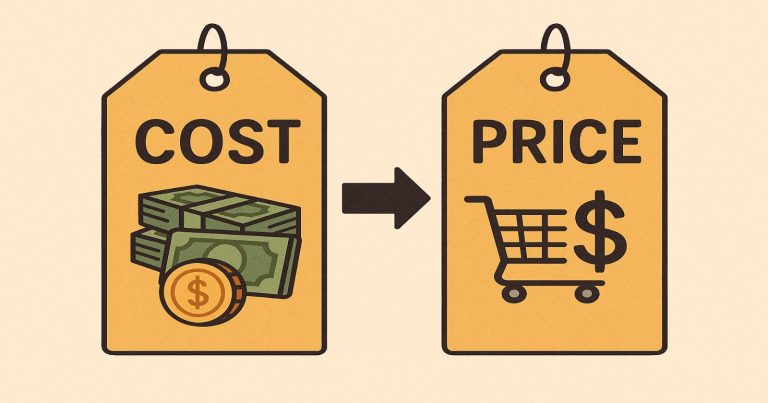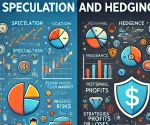In business, you often hear the words cost and price. Many people think they mean the same thing. But they are not the same. The difference between cost and price is very important. Cost is the money a company spends to make a product. Price is the money a customer pays to buy that product. This is the basic answer to the topic. If a company wants to make profit, it must sell the product at a price higher than the cost. It tells you how much you spend and how much you earn. Many times, people confuse cost with price. This mistake can lead to loss in business. For example, if you spend Rs. 100 to make a shirt and sell it for Rs. 90, you lose Rs. 10. That is why knowing both is important.
Key Difference Between Cost and Price
The cost is the expense. The price is the selling amount. Cost comes first, then price. The company spends money to make. Then it decides what to charge. That is the price.
Meaning: Cost is the amount a company spends to make or buy a product. Price is the amount a customer pays to buy that product. So, cost is the input and price is the output.
Focus: The cost focuses on the producer or seller. It shows how much is spent. Price focuses on the buyer. It shows how much they pay.
Objective: The main aim of cost is to control expenses. The goal of price is to earn profit.
Accounting: Cost appears in internal records. It is useful for business planning. Price appears in sales invoices and revenue statements.
Market Role: Cost stays mostly the same unless inputs change. But price depends on the market, demand, and competition.
Control: A business can control cost by using resources wisely. But the market controls the price more than the seller.
Impact on Profit: If cost goes down and price stays the same, profit increases. If cost goes up and price stays the same, profit goes down.
| Basis | Cost | Price |
| Meaning | Money spent to produce goods | Money received for selling goods |
| Concerned With | Manufacturer/Seller | Buyer/Consumer |
| Nature | Internal business expense | External market transaction |
| Fixed or Variable | Can be fixed or variable | Often flexible as per demand |
| Shown In | Cost sheets, accounting records | Sales invoices, bills |
| Affects | Production, budgeting | Sales, revenue, and profit |
| Decision Factor | Helps decide minimum price | Decided based on market situation |
More Explanation with Examples
Let us take an example. Ravi makes handmade soaps. He spends Rs. 20 on raw materials, Rs. 10 on labor, and Rs. 5 on packaging. Total cost = Rs. 35. He adds Rs. 15 as profit. Final price = Rs. 50.
- Rs. 35 = Cost
- Rs. 50 = Price
If Ravi does not know his cost, he may sell it for Rs. 30. Then he will face a loss. That is why every business must know the difference between cost and price.
What is Cost?
Cost is the total money used to make or get a product or service. It includes everything. This includes raw materials, labor, packaging, electricity, transport, rent, and more. When you make a cake, the cost includes flour, sugar, gas, time spent, and even the box you put it in.
Cost is very important in business. It tells how much money the company has spent. If you know the cost clearly, you can set the right price. Many Indian students learn about cost in school and college. They understand that knowing cost helps to plan budgets.
Types of Costs in Business
- Fixed Cost: This does not change. Example: Rent of your shop.
- Variable Cost: This changes with how much you make. Example: Raw materials.
- Direct Cost: This is spent directly to make the product. Example: Wood for furniture.
- Indirect Cost: This is general expense. Example: Office electricity.
- Opportunity Cost: This is the benefit you miss by not choosing another option.
All these costs add up to total cost. A business must always try to control its cost. If cost goes up too much, profit will fall.
Cost in Accounting
In accounting, cost helps to find profit. Profit = Selling Price – Cost. If cost is not correct, profit will be wrong too. Accountants check all types of costs before making reports. This helps business owners make good decisions.
What is Price?
Price is the amount of money a customer pays to buy a product or service. The company sets this amount after checking the cost. Price also depends on demand, market trend, and brand value. It can change often.
Price is very important in trade. In India, price also depends on GST and other taxes. When people see the price tag on a product, they decide whether to buy or not. If the price is high, people might not buy. If it’s too low, the company might lose money.
Factors That Affect Price
- Cost of production: Higher cost means higher price.
- Market demand: High demand means high price.
- Competition: More sellers often reduce price.
- Brand value: Big brands charge more.
- Government rules: Taxes and price caps affect price.
Companies use price to cover their cost and earn profit. That is why price is always more than cost.
Price in Real Life
Let us look at an example. You go to a bakery. The cake costs Rs. 200 to make. The bakery adds Rs. 50 more as profit. The final price is Rs. 250. That is what you pay. So, Rs. 200 is the cost, Rs. 250 is the price.
Difference between cost and price FAQs
1. What is the main difference between cost and price?
Cost is the money spent to make a product. Price is the money charged from the customer to sell it.
2. Can price be lower than cost?
Yes, but it causes loss. Businesses avoid this. This may happen during sales or clearance.
3. What is the cost price in business?
It is the exact cost spent to make the product, including materials, labor, and other expenses.
4. How do I calculate cost and price?
Add all expenses for cost. Then add profit margin to decide price.
5. Why is cost important in accounting?
It helps find profit. Accountants use cost to calculate total expenses.


